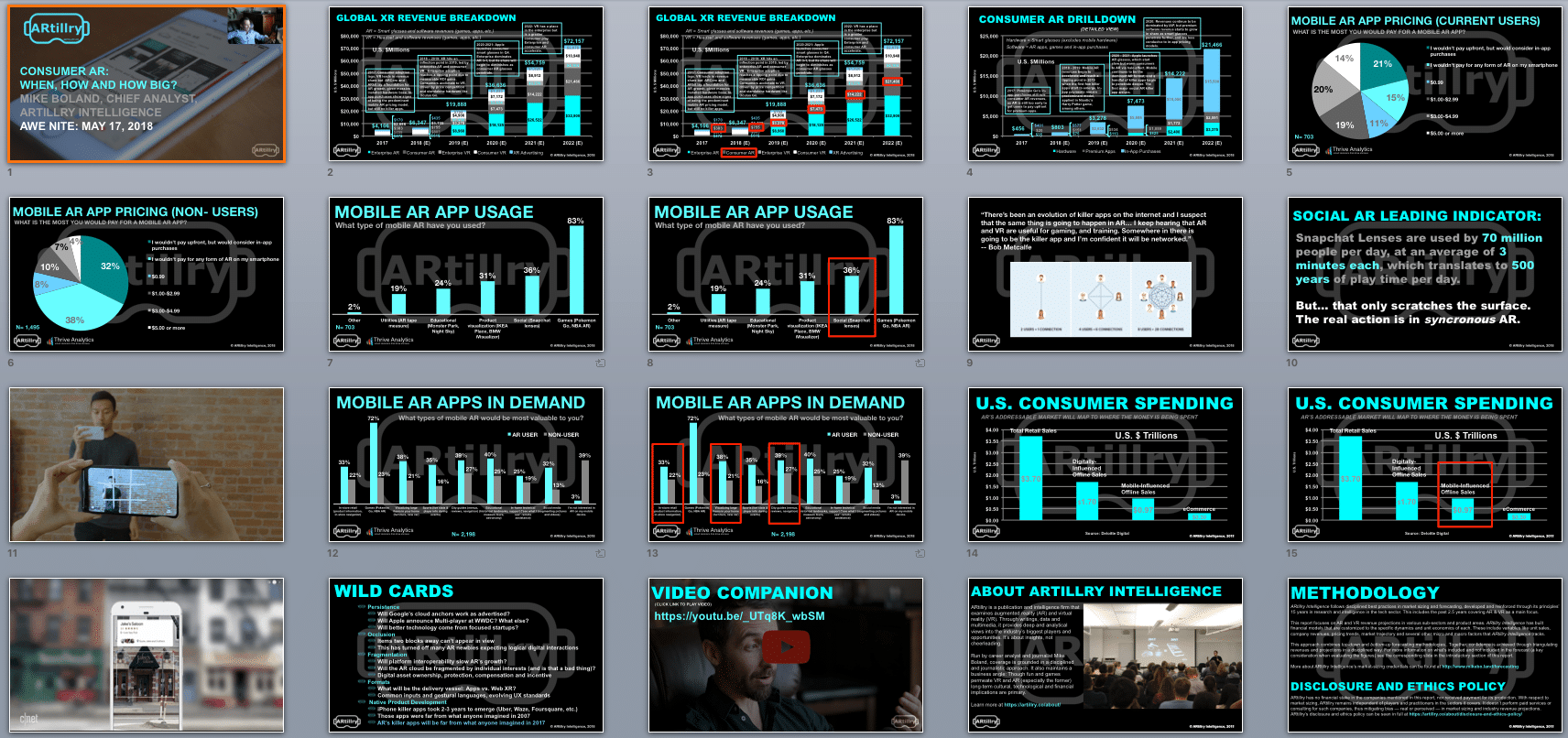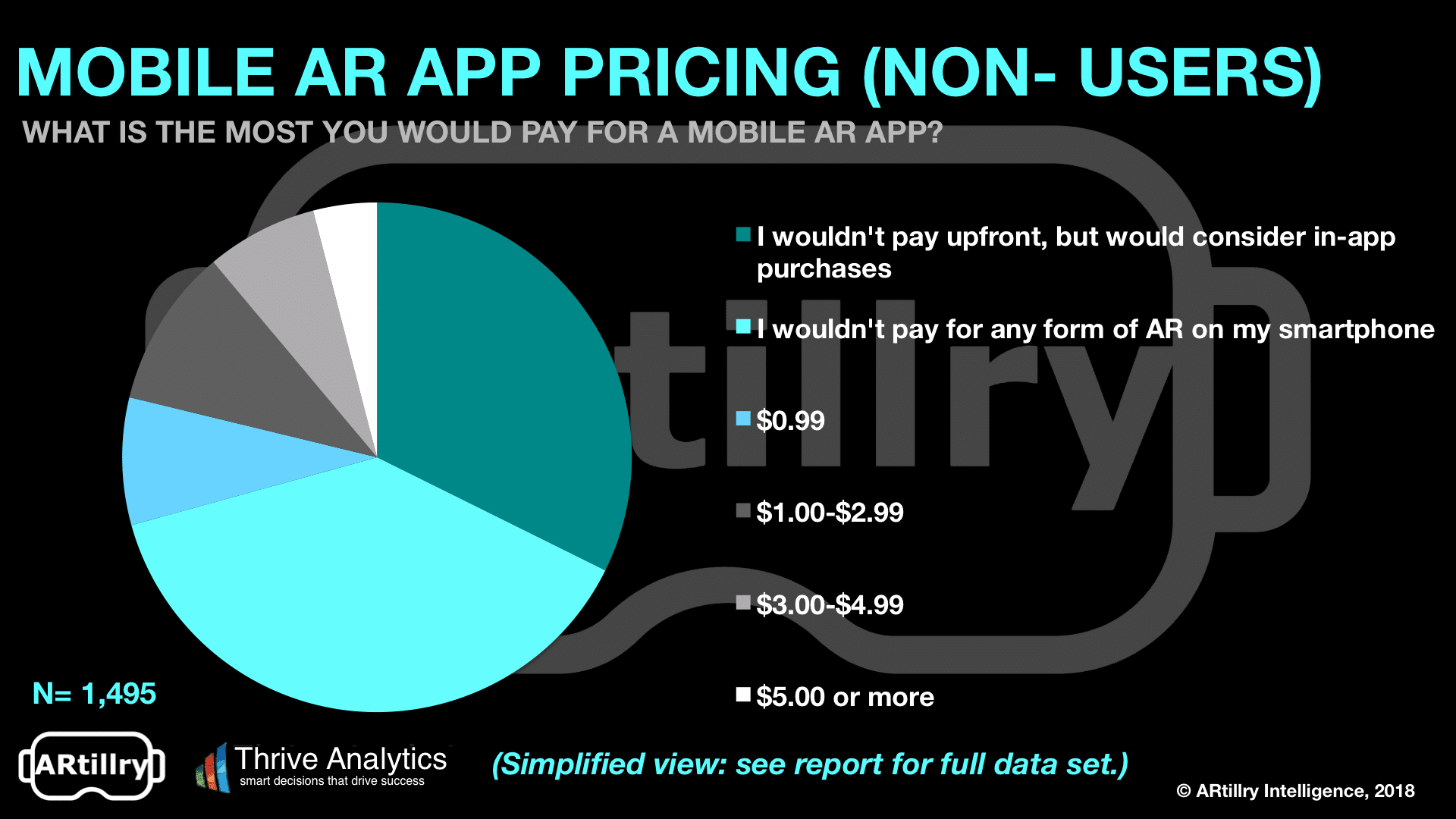
ARtillry Workshop is an ongoing series of video presentations (slides and audio voiceover) containing XR data and strategic insights. The video is embedded below, following a narrative summary.
How big is the consumer AR revenue opportunity? What factors will determine its fate? And what sub-sectors represent the biggest opportunities? These are questions we tackle in the latest ARtillry Workshop (video below). Spoiler: we’re big on social and local commerce apps.
To summarize, consumer AR revenues will grow to $19 billion by 2022, made up of hardware and different flavors of software revenue. Dedicated AR hardware won’t emerge as a considerable revenue source until the 2021 time frame, meaning near-term strategies are all about software.
That includes premium apps and in-app purchases. The former will grow in later years, correlated to the growth in smart glasses. That’s because upfront purchases is how software will be bought for AR glasses. Think of it like how software (games, apps, etc.) are sold for VR.

In-App is Where It’s At
But until that glasses-based day for AR arrives, mobile rules. And mobile AR software models follow a path already set in the smartphone app economy. There, the prevailing model for higher ARPU is in-app purchases. It’s been proven for both yield optimization and consumer acclimation.
Moreover, in-app purchases have been validated specifically within AR, considering it’s Pokemon Go’s primary revenue source. We’ll see that extend to other IP that builds on Pokemon Go’s architecture and game mechanics, including Harry Potter and Ghostbusters.
Lastly in support of in-app purchases’ mobile AR dominance, it’s a model that’s proving to resonate with consumers. At these early stages of mobile AR, many aren’t yet ready to commit upfront dollars for apps, especially new users. This can be seen in our recent survey data.

Network Effect
Moving beyond market sizing and pricing models, it’s also important to examine the types of apps that resonate with consumers. Not surprisingly, games dominate. Coming in second place is social AR, which we believe will represent an area of lots of killer apps in the coming years.
Social can not only accelerate AR’s consumer adoption through viral growth and network effect, but it’s showing strong engagement metrics. As an early indicator of that potential, Snapchat lenses are used by 70 million consumers daily, with session durations around 3 minutes each.
This only scratches the surface as Snapchat Lenses are what we call asynchronous AR. In other words, the augmentation happens to recorded media (selfies, video, etc.) which is then shared and consumed asynchronously. The real growth will come with syncronous, multi-player AR.

We’re getting closer to that goal with the advancement of the AR cloud, image persistence and other key factors. Google announced cloud anchors at I/O for example, and we expect image persistence and multiplayer support in ARkit to be announced at WWDC in a few weeks.
These and other factors will shape the consumer AR opportunity, not to mention AR’s collision with local offline commerce, which will be a considerable revenue category. The AR cloud will tie it all together and determine how (and when) the sector arrives at our revenue projections.
On the front end, it will be all about killer apps. As a historical precedent, it’s important to note that iPhone killer apps didn’t arrive until 2-3 years after the device’s launch. Could AR follow a similar path, meaning killer apps 2-3 years after ARkit? That could mean sometime late next year.
Check out the full presentation below, which includes slides and audio voiceover. And stay tuned for updated figures in our upcoming forecast refresh.
For deeper XR data and intelligence, join ARtillry PRO and subscribe to the free ARtillry Weekly newsletter.
Disclosure: ARtillry has no financial stake in the companies mentioned in this post, nor received payment for its production. Disclosure and ethics policy can be seen here.
Header Image Credit: Snap Inc.
